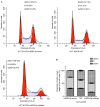MicroRNA-93-5p increases multidrug resistance in human colorectal carcinoma cells by downregulating cyclin dependent kinase inhibitor 1A gene expression
- PMID: 28356951
- PMCID: PMC5351191
- DOI: 10.3892/ol.2016.5463
MicroRNA-93-5p increases multidrug resistance in human colorectal carcinoma cells by downregulating cyclin dependent kinase inhibitor 1A gene expression
Abstract
Multidrug resistance (MDR) impedes successful chemotherapy in colorectal carcinoma (CRC) and emerging evidence suggests that microRNAs (miRs) are involved in the development of MDR. In the present study, the role of miR-93-5p in the modulation of drug resistance in CRC was investigated using HCT-8 and MDR HCT-8/vincristine (VCR) cell lines. The results demonstrated upregulated expression of miR-93-5p and MDR protein 1 (MDR1) in HCT-8/VCR cells, compared with the parental HCT-8 cells. Furthermore, cyclin-dependent kinase inhibitor 1A (CDKN1A) was identified as a potential target of miR-93-5p using miR target analysis tools, including PicTar, TargetScan and miRanda. In addition, inhibition of miR-93-5p expression in HCT-8/VCR cells markedly downregulated MDR1 gene expression, upregulated CDKN1A gene expression and induced cell cycle arrest in G1. Conversely, the overexpression of miR-93-5p in HCT-8/VCR cells upregulated MDR1 gene expression, downregulated CDKN1A gene expression and promoted G1/S transition. Furthermore, the in vitro drug sensitivity assay performed suggested that downregulation of miR-93-5p enhanced the sensitivity of HCT-8/VCR cells to VCR, while the upregulation of miR-93-5p decreased the sensitivity of HCT-8 cells to VCR. In conclusion, the results of the present study suggest that miR-93-5p serves a role in the development of MDR through downregulating CDKN1A gene expression in CRC.
Keywords: colorectal carcinoma; cyclin dependent kinase inhibitor 1A; microRNA-93; multidrug resistance; multidrug resistance protein 1.
Figures





Similar articles
-
miR-106b-5p promotes cell proliferation and cell cycle progression by directly targeting CDKN1A in osteosarcoma.Exp Ther Med. 2020 May;19(5):3203-3210. doi: 10.3892/etm.2020.8574. Epub 2020 Mar 6. Exp Ther Med. 2020. PMID: 32266016 Free PMC article.
-
MicroRNA-9-5p increases the sensitivity of colorectal cancer cells to 5-fluorouracil by downregulating high mobility group A2 expression.Oncol Lett. 2021 Mar;21(3):235. doi: 10.3892/ol.2021.12496. Epub 2021 Jan 26. Oncol Lett. 2021. PMID: 33613724 Free PMC article.
-
miR-139-5p sensitizes colorectal cancer cells to 5-fluorouracil by targeting NOTCH-1.Pathol Res Pract. 2016 Jul;212(7):643-9. doi: 10.1016/j.prp.2016.04.011. Epub 2016 May 3. Pathol Res Pract. 2016. PMID: 27173050
-
miR-15b and miR-16 modulate multidrug resistance by targeting BCL2 in human gastric cancer cells.Int J Cancer. 2008 Jul 15;123(2):372-379. doi: 10.1002/ijc.23501. Int J Cancer. 2008. PMID: 18449891
-
MiR-139-5p reverses CD44+/CD133+-associated multidrug resistance by downregulating NOTCH1 in colorectal carcinoma cells.Oncotarget. 2016 Nov 15;7(46):75118-75129. doi: 10.18632/oncotarget.12611. Oncotarget. 2016. PMID: 27738333 Free PMC article.
Cited by
-
Tumor Microenvironment Remodeling in Gastrointestinal Cancer: Role of miRNAs as Biomarkers of Tumor Invasion.Biomedicines. 2023 Jun 19;11(6):1761. doi: 10.3390/biomedicines11061761. Biomedicines. 2023. PMID: 37371856 Free PMC article. Review.
-
A Systematic Review of MicroRNAs Involved in Cervical Cancer Progression.Cells. 2021 Mar 17;10(3):668. doi: 10.3390/cells10030668. Cells. 2021. PMID: 33803022 Free PMC article.
-
Downregulating Long Non-coding RNAs CTBP1-AS2 Inhibits Colorectal Cancer Development by Modulating the miR-93-5p/TGF-β/SMAD2/3 Pathway.Front Oncol. 2021 Apr 14;11:626620. doi: 10.3389/fonc.2021.626620. eCollection 2021. Front Oncol. 2021. PMID: 33937030 Free PMC article.
-
The role of non-coding RNAs in chemotherapy for gastrointestinal cancers.Mol Ther Nucleic Acids. 2021 Oct 8;26:892-926. doi: 10.1016/j.omtn.2021.10.004. eCollection 2021 Dec 3. Mol Ther Nucleic Acids. 2021. PMID: 34760336 Free PMC article. Review.
-
MiRNA-93: a novel signature in human disorders and drug resistance.Cell Commun Signal. 2023 Apr 19;21(1):79. doi: 10.1186/s12964-023-01106-3. Cell Commun Signal. 2023. PMID: 37076893 Free PMC article. Review.
References
-
- Henaine AM, Chahine G, Salameh P, Elias E, Massoud M, Hartmann D, Aulagner G, Armoiry X. MANAGEMENT OF METASTATIC COLORECTAL CANCER: Current Treatments and New Therapies. J Med Liban. 2015;63:218–227. - PubMed
LinkOut - more resources
Full Text Sources
Other Literature Sources
Research Materials
